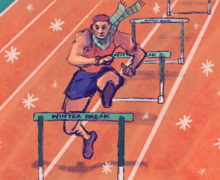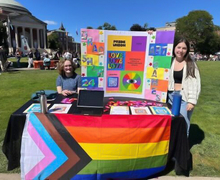How the 2nd COVID-19 wave in India is affecting these SU students, their loved ones
Francis Tang | Staff Writer
Although most of Setu Desai's family have received one dose of the vaccine, none of them could receive the second because of the shortage of vaccine supplies and medical facilities.
Get the latest Syracuse news delivered right to your inbox.
Subscribe to our newsletter here.
Since the second wave of the COVID-19 pandemic began sweeping through India, Setu Desai has been concerned about his family thousands of miles away.
Desai, a Syracuse University graduate student studying computer engineering, went back home to Ahmedabad, a city in the Gujarat state of India, for the winter break. But now, the distance from campus to home seems farther than ever.
“It is not something out of nowhere,” Desai said. “People were not very cautious about it, things like social distancing in public spaces.”
Both Desai’s mother and grandmother have tested positive for coronavirus during the second wave. Although Desai’s mother received the first dose of the Indian-made Covishield vaccine early on, she still tested positive to the virus 22 days later.
Desai was fully vaccinated in the United States by late April. Although most of his family have received one dose of the vaccine, none of them could receive the second because of the shortage of vaccine supplies and medical facilities.
Desai’s grandmother has previous medical conditions: diabetes, high cholesterol and high blood pressure. A doctor suggested she stop COVID-19 treatment after she started experiencing side effects, but the family was not sure about whether to do so or not.
“People are losing their loved ones due to lack of ventilators and oxygen. The government is blindsiding these issues and conducting elections and gathering people for rallies,” Desai said. “This is very serious and the negligence is creating chaos.”
Tanushri Majumdar, an SU graduate student studying international relations at the Maxwell School of Citizenship and Public Affairs, has family members who tested positive for COVID-19 around mid-April.
“(My parents) called me one day, and they were like, we all tested positive. We all got COVID and your dad has a 103 fever,” Majumdar said.
Although Majumdar’s family recovered, some lasting effects still remain. She was shocked when she finally saw her father, who lost weight due to COVID-19, on video.
Majumdar said she still feels her family is lucky because they have access to medical treatment resources that other people might not have, such as virtual doctors and the ability to have medicine delivered to their home.
“My aunt’s cousin lost both her husband and her son in two days. My friend’s father is on a ventilator right now, but she can’t go home and see him,” Majumdar said. “It’s been really, really stressful. Everyone I know has lost someone to COVID. The news said it’s bad, but it’s so much worse.”
The dense population and low vaccine rate in India has made the more transmittable variant, known as B.1.617, sweep through the country, said Christopher P. Morley, professor and chair of the Department of Public Health & Preventive Medicine at SUNY Upstate Medical University, in a statement to The Daily Orange.
“Simple evolutionary pressure is driving all of the variant emergence,” Morley added. “Viruses, like all living organisms, continually evolve. However, the more a virus reproduces, the more opportunity it has to evolve; uncontrolled infections lead to greater opportunity to evolve.”
The Indian government’s negligence is responsible for the deteriorating situation, Desai and Majumdar said. Election rallies are still in place across India without social distancing, according to BBC News. Millions of people gathered for Kumbh Mela, a traditional Hindu festival, earlier in April, which has caused massive infections of the disease, BBC News reported.
“I think the whole situation just amplifies a lot of existing political problems,” said Vasundhra Aggarwal, an SU senior architecture student from Delhi, India. “I don’t think the government can instate another full lockdown without riots and stuff like that, because the working class cannot afford not to go to work.”
Aggarwal and Majumdar were disappointed by the way that the western countries have been restricting resources, like vaccines, to the Global South, they said. Less than 3% of India’s total population has been fully vaccinated, while the U.S. has over 32% as of Wednesday, according to data from Johns Hopkins University.
“It is a collective problem that we all need to deal with, rather than an individual one,” Aggarwal said.
On April 30, the Biden Administration announced to restrict most travels between the U.S. and India effective May 4, creating travel issues for international students.
Aggarwal is graduating at the end of the spring semester. Although she has already secured a job in the U.S. after graduation, she cannot go back home as long as the U.S. Embassy and consulates in India are still closed, as her student visa will expire in July.
Desai and Majumdar will also graduate from SU in a few days. Both of them are still looking for opportunities, such as internships, to stay in the U.S. after graduation.
Banning travel from just one country is ineffective, Morley said. Although the travel ban may slow down the spread of the new variant to the U.S., it is unlikely to prevent it in the long term.
Morley fears the new variant identified in India will eventually spread in the U.S. as it has in other countries, including Canada. Most vaccines – including those we have available in the U.S. – appear to be effective in limiting the severity and reducing transmission of all of the variants currently identified, Morley said.
Morley said continued vigilance and prevention strategies towards the pandemic are important.
“This is not a vaccine failure. It is more a failure to get vaccines administered in a timely fashion, and a failure to continue to rely upon non-pharmaceutical interventions like masking and distancing,” Morley said.
Majumdar said the blame for the crisis should lie with the government.
“I think just politically, foreign governments have to hold our government accountable,” she said. “Because India is going through something, and that’s the government’s fault.”
Published on May 13, 2021 at 12:31 am
Contact Francis: btang05@syr.edu | @francis_towne






